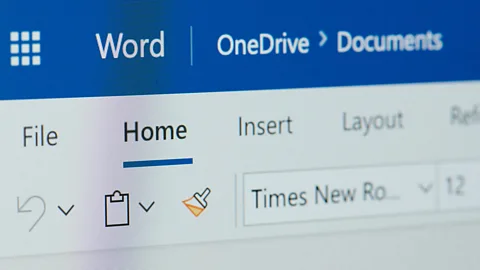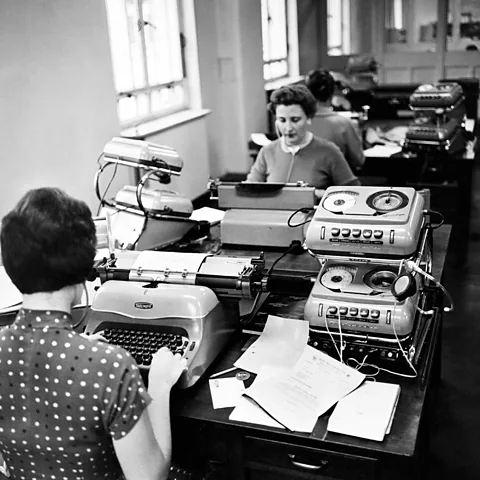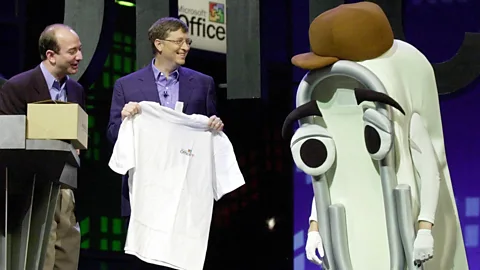The surprisingly subtle ways Microsoft Word has changed how we use language
 Alamy
AlamyAs Microsoft Word turns 40, we look at the role the software has played in four decades of language and communication evolution.
For 40 years there’s been an invisible hand guiding the way many of us write, work, and communicate. Its influence has been pervasive, yet its impact has been subtle to the extent that you’ve likely never noticed. That invisible hand is Microsoft Word.
At its launch in October 1983, this influential software was known as Multi-Tool Word, and not long after, changed to Microsoft Word for Dos. Back then, there were more than 300 word processing programs across multiple platforms. People of a certain age will remember WordStar or WordPerfect, yet in a little over a decade Word eclipsed these rivals. By 1994, Microsoft says it had claimed a 90% share of the word-processing market, making it one of the most successful, well-known software products in history.
While establishing how many people use Word is tricky, recent filings show there are 1.4 billion Windows devices in use each month, and more than 90% of the Fortune 500 use the software. If only a third of those people used Word, it would still be more than the population of North America.
This context is important because it helps to explain why, and how, Word has had such influence on our lives.
Ironically, given its ubiquity, Word has rarely been a pioneer when it comes to features. As mentioned, it was far from the first word processor. It’s often credited with introducing grammar tools, despite the fact these were developed decades earlier. And the idea behind "track changes" – where you can see edits to a document – wasn’t a Microsoft invention.
Yet Word’s superpower was using smart, simple design choices to make such features accessible to a global audience, not just techies. Its "What You See is What You Get" (WYSIWYG) design philosophy is now commonplace in software and on the internet. Word introduced line breaks, along with bold and italic fonts on screen. It revolutionised typeset-quality printing, as well as the use of templates. And it was in these templates that Word’s early impact on communication emerged.
 Getty Images
Getty ImagesSign up for Tech Decoded
For more technology news and insights, sign up to our Tech Decoded newsletter. The twice-weekly email decodes the biggest developments in global technology, with analysis from BBC correspondents around the world. Sign up for free here.
"Word templates led people to use the same formatting in communications, and eventually, this has become instantiated as a norm," says Gloria Mark, a professor of informatics at the University of California, Irvine, where she studies human-computer interaction. If you work in finance, there's a specific way reports are expected to be laid out. Letters follow a set pattern, memos are largely formatted in the same way. "Users know where to find information in these standardised documents; they don’t need to spend time trying to find what they need."
If you take this idea of professional conformity a step further, Word has also been significant in helping establish English as the global language of business. While it would be an overstatement to say Word alone made English the dominant language, as a US firm, Microsoft's mother-tongue is American-English. When this is coupled with Word’s ubiquity, it at least reinforces this dominance.
"Word primarily operates in English," says Noël Wolf, a linguistic expert at the language learning platform Babbel. "As businesses become increasingly global, the widespread use of Word in professional and technical fields has led to the borrowing of English terms and structures, which contribute to the trend of linguistic homogenisation."
Word's spell-checker and grammar features have become subtle arbiters of language, too. Although seemingly trivial, these tools "promote a sense of consistency and correctness", says Wolf, and this uniformity comes at the cost of writing diversity. "Writers, when prompted by the software's automated norms, might unintentionally forsake their unique voices and expressions."
This becomes even more invasive when you look at the role and impact of autocorrect and predictive text. Today, when typing on Word, the software can automatically correct your spelling, and make suggestions for what to write next. These suggestions aren't (yet) based on your personal writing style and tone – they're rule-based. The suggestions you see will be the same as millions of others. Again, this may feel innocuous but it's another example of how Word standardises language by loosely guiding everyone down the same path.
"Without auto-completion, a person might check a thesaurus when searching for a word," says Mark. "With auto-completion, it can lead to more rote use of language and may not encourage original writing."
For those trying to learn a language, or even get better at their native tongue, features such as autocorrect have been found to have a negative impact on student's writing abilities and spelling skills. There is also some evidence that, in adults at least, rather than making users lazy spellers, autocorrect features can reduce exposure to misspellings and so avoid the disruptive impact this can have on our memory for how a word should be spelt.
Clippy: the assistant that users loved to hate
Another cultural legacy of Microsoft Word is a character called Clippy. Around the turn of the century, this animated paperclip would pop up in the Office programs offering help with drafting. Clippy's badgering tone and lack of common sense made it widely unpopular, so it was eventually discontinued. However, Clippy lives on in pop culture as an internet meme, where its passive-aggressive advice is used for humour. In academic circles, it is also widely cited as an example of a failure in technological pedagogy. For those missing Clippy, however, the character has made a reappearance in Microsoft Teams.
Wolf adds that by promoting uniformity in written communication, grammar and spelling features in word processors such as Word "enforce established language norms".
"Word may not recognise vocabulary or grammar conventions that are part of local dialects, and will try to correct them," she says. This can effectively marginalise regional nuance, she adds. On an individual scale, these impacts may seem minimal but they become magnified when repeated on a software that has millions, if not billions of users.
Such tools play a broader role in the evolution of language more generally, too. Because Word defaults to US-English, so too do its spellchecking features. Write a word ending in "-ise" and it will suggest changing it to "-ize", unless you've taken the time to change the default settings.
Of course, it is worth remembering that Word isn't just available in English. It supports around 100 languages, including European Spanish and Latin-American Spanish.
But when the differences between dialects are subtle, the suggestions made by the software become less noticeable and more persuasive.
Take the word "trialing/trialling" for instance. "Trialing" is considered the US-English spelling. The Oxford English Dictionary (OED) doesn't even recognise "trialing" as a word, instead, opting for the use of the double-L common in British-English. Despite such a clear distinction by the OED, the American spelling regularly makes its way into British-English publications and style guides. There's an argument that this is because of increasingly global audiences and would again be an overstatement to lay the increasing Americanisation of English entirely at the feet of a piece of word processing software, but as part of influence of American culture has had on language more generally, it may have played a role.
Similarly, the efficiency brought about by standardisation can shape how we write, not just what we write. When clarity is put ahead of stylistic or poetic flair – Word's grammar checker has a specific "clarity" refinement option – it can have implications for how we value forms of creativity.
Based on a quick, albeit arbitrary, experiment, if Harper Lee had used Word to write To Kill a Mockingbird, the software's clarity refinement would have suggested changing: "I never loved to read. One does not love breathing," to "I never loved to read. Breathing is necessary." Does this remove the poetry and depth of the original? The example is somewhat facetious, but it illustrates the effects using such tools can have. In an age where clarity and readability are prioritised by search engines, and in which the glut of online content is said to be shrinking our attention span, such seemingly subtle shifts could potentially have far-reaching impact on creative writing.
 Getty Images
Getty ImagesYet there’s no denying Word has improved accessibility and diversity in myriad other ways. By bringing word processing into people's homes, it has empowering more people to write, create and contribute. This increases diversity of voice, rather than impeding it. In 2018, Microsoft added dictation features into Word to empower people with dyslexia and dysgraphia to easily type with their voice. It is one of a number of accessibility features in the software.
In the early days of its adoption, word processing was even linked with promoting greater, not worse, essay-writing prowess. In a 1992 study, essays written on a word processor were rated "significantly higher" than those written by hand. Word processing allowed students to make "microstructural rather than macrostructural" changes to their work, and by being able to continuously revise their writing, the end result was seemingly improved.
According to Wolf, word processing has taken some of the cognitive load out of writing, which allows more space for creativity. For example, while spell-check may not promote spelling retention, "when used mindfully, spell-checkers serve as valuable aids by enhancing language proficiency and communication", says Wolf. "They enable users to focus on word choice and strategy of communication rather than spending time and energy pinning down the correct spelling."
This has the potential to become even more impactful as artificial intelligence (AI) is integrated into word processing. But opinion is divided. On one hand, by removing technical aspects of spelling, sentence construction and so on, AI may free people up to be even more creative. Its ability to learn and understand a person's unique writing style could lead to an era of highly personal, unencumbered imagination. "[Generative AI] cannot be entirely relied upon to produce accurate prose every time, but it can reduce the process of creating text to editing," according to Ed Challis, head of AI strategy at UiPath, which develops robotic automation software. He believes this will "lead to innovations across all areas of content creation and communication".
That said, a potential over-reliance on automation could discourage users from actively learning and improving their linguistic and written skills, believes Wolf. If large language models are being trained on decades of increasingly homogenised content, there's the risk this will make things worse, not better.
Whatever happens, the next 40 years are likely to continue the push-pull effect Word has had on language and society over the previous 40.
"Microsoft Word's impact on linguistic evolution is a complex interplay between standardisation and diversification," says Wolf. "It can homogenise language but also enables expression in various languages. The ultimate impact depends on how individuals and communities choose to use this powerful tool in the evolving landscape of global communication."
--
If you liked this story, sign up for The Essential List newsletter – a handpicked selection of features, videos and can't-miss news delivered to your inbox every Friday.
